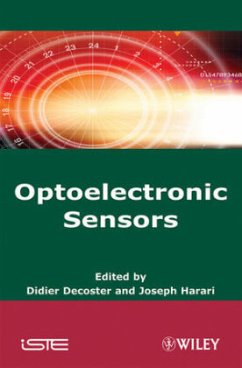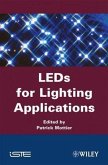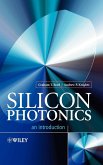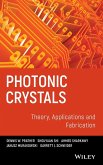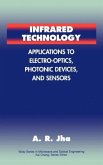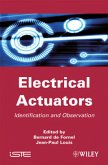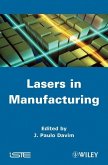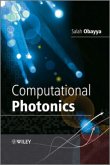Optoelectronic Sensors
Herausgegeben von Decoster, Didier; Harari, Joseph
Optoelectronic Sensors
Herausgegeben von Decoster, Didier; Harari, Joseph
- Gebundenes Buch
- Merkliste
- Auf die Merkliste
- Bewerten Bewerten
- Teilen
- Produkt teilen
- Produkterinnerung
- Produkterinnerung
Optoelectronic sensors combine optical and electronic systems for numerous applications including pressure sensors, security systems, atmospheric particle measurement, close tolerance measurement, quality control, and more. This title provides an examination of the latest research in photonics and electronics in the areas of sensors.
Andere Kunden interessierten sich auch für
![Led for Lighting Applications Led for Lighting Applications]() Patrick MottierLed for Lighting Applications170,99 €
Patrick MottierLed for Lighting Applications170,99 €![Silicon Photonics Silicon Photonics]() Graham T. ReedSilicon Photonics167,99 €
Graham T. ReedSilicon Photonics167,99 €![Photonic Crystals, Theory, Applications and Fabrication Photonic Crystals, Theory, Applications and Fabrication]() Dennis W PratherPhotonic Crystals, Theory, Applications and Fabrication179,99 €
Dennis W PratherPhotonic Crystals, Theory, Applications and Fabrication179,99 €![Infrared Technology Infrared Technology]() A. R. JhaInfrared Technology312,99 €
A. R. JhaInfrared Technology312,99 €![Electrical Actuators Electrical Actuators]() Bernard de FornelElectrical Actuators222,99 €
Bernard de FornelElectrical Actuators222,99 €![Laser in Manufacturing Laser in Manufacturing]() Laser in Manufacturing177,99 €
Laser in Manufacturing177,99 €![Computational Photonics Computational Photonics]() Salah ObayyaComputational Photonics125,99 €
Salah ObayyaComputational Photonics125,99 €-
-
-
Optoelectronic sensors combine optical and electronic systems for numerous applications including pressure sensors, security systems, atmospheric particle measurement, close tolerance measurement, quality control, and more. This title provides an examination of the latest research in photonics and electronics in the areas of sensors.
Hinweis: Dieser Artikel kann nur an eine deutsche Lieferadresse ausgeliefert werden.
Hinweis: Dieser Artikel kann nur an eine deutsche Lieferadresse ausgeliefert werden.
Produktdetails
- Produktdetails
- Verlag: ISTE / Wiley & Sons
- 1. Auflage
- Seitenzahl: 256
- Erscheinungstermin: 1. August 2009
- Englisch
- Abmessung: 235mm x 162mm x 21mm
- Gewicht: 548g
- ISBN-13: 9781848210783
- ISBN-10: 1848210787
- Artikelnr.: 26459444
- Herstellerkennzeichnung
- Libri GmbH
- Europaallee 1
- 36244 Bad Hersfeld
- gpsr@libri.de
- Verlag: ISTE / Wiley & Sons
- 1. Auflage
- Seitenzahl: 256
- Erscheinungstermin: 1. August 2009
- Englisch
- Abmessung: 235mm x 162mm x 21mm
- Gewicht: 548g
- ISBN-13: 9781848210783
- ISBN-10: 1848210787
- Artikelnr.: 26459444
- Herstellerkennzeichnung
- Libri GmbH
- Europaallee 1
- 36244 Bad Hersfeld
- gpsr@libri.de
Didier Decoster is an Associate Professor in the Department of Veterinary Clinical Medicine, at the University of Illinois, USA.
Preface xi
Chapter 1. Introduction to Semiconductor Photodetectors 1
Franck OMNES
1.1. Brief overview of semiconductor materials 1
1.2. Photodetection with semiconductors: basic phenomena 3
1.3. Semiconductor devices 4
1.4. p-n junctions and p-i-n structures 5
1.5. Avalanche effect in p-i-n structures 7
1.6. Schottky junction 8
1.7. Metal-semiconductor-metal (MSM) structures 10
1.8. Operational parameters of photodetectors 11
Chapter 2. PIN Photodiodes for the Visible and Near-Infrared 15
Baudoin DE CREMOUX
2.1. Introduction 15
2.2. Physical processes occurring in photodiodes 17
2.3. Static characteristics of PIN photodiodes 25
2.4. Dynamic characteristics of PIN photodiodes 34
2.5. Semiconductor materials used in PIN photodiodes for the visible and
near-infrared 42
2.6. New photodiode structures 49
2.7. Bibliography 55
Chapter 3. Avalanche Photodiodes 57
Gérard RIPOCHE and Joseph HARARI
3.1. Introduction 57
3.2. History 58
3.3. The avalanche effect 60
3.4. Properties of avalanche photodiodes 66
3.5. Technological considerations 76
3.6. Silicon avalanche photodiodes 80
3.7. Avalanche photodiodes based on gallium arsenide 88
3.8. Germanium avalanche photodiodes 90
3.9. Avalanche photodiodes based on indium phosphate (InP) 95
3.10. III-V low-noise avalanche photodiodes 100
3.11. Prospects 104
3.12. Conclusion 106
3.13. Bibliography 107
Chapter 4. Phototransistors 111
Carmen GONZALEZ and Antoine MARTY
4.1. Introduction 111
4.2. Phototransistors 112
4.3. The bipolar phototransistor: description and principles of operation
118
4.4. Photodetector circuits based on phototransistors 140
4.5. Applications 142
4.6. Conclusion 150
4.7. Bibliography 151
Chapter 5. Metal-Semiconductor-Metal Photodiodes 155
Joseph HARARI and Vincent MAGNIN
5.1. Introduction 155
5.2. Operation and structure 156
5.3. Static and dynamic characteristics 165
5.4. Integration possibilities and conclusion 177
5.5. Bibliography 178
Chapter 6. Ultraviolet Photodetectors 181
Franck OMNES and Eva MONROY
6.1. Introduction 181
6.2. The UV-visible contrast 189
6.3. Si and SiC photodetectors for UV photodetection 190
6.4. UV detectors based on III-V nitrides 195
6.5. Conclusion 216
6.6. Bibliography 218
Chapter 7. Noise in Photodiodes and Photoreceiver Systems 223
Robert ALABEDRA and Dominique RIGAUD
7.1. Mathematical tools for noise 224
7.2. Fundamental noise sources 227
7.3. Excess noise 232
7.4. Analysis of noise electrical circuits 235
7.5. Noise in photodetectors 239
7.6. Noise optimization of photodetectors 245
7.7. Calculation of the noise of a photoreceiver 253
7.8. Comments and conclusions 266
7.9. Bibliography 268
List of Authors 269
Index 271
Chapter 1. Introduction to Semiconductor Photodetectors 1
Franck OMNES
1.1. Brief overview of semiconductor materials 1
1.2. Photodetection with semiconductors: basic phenomena 3
1.3. Semiconductor devices 4
1.4. p-n junctions and p-i-n structures 5
1.5. Avalanche effect in p-i-n structures 7
1.6. Schottky junction 8
1.7. Metal-semiconductor-metal (MSM) structures 10
1.8. Operational parameters of photodetectors 11
Chapter 2. PIN Photodiodes for the Visible and Near-Infrared 15
Baudoin DE CREMOUX
2.1. Introduction 15
2.2. Physical processes occurring in photodiodes 17
2.3. Static characteristics of PIN photodiodes 25
2.4. Dynamic characteristics of PIN photodiodes 34
2.5. Semiconductor materials used in PIN photodiodes for the visible and
near-infrared 42
2.6. New photodiode structures 49
2.7. Bibliography 55
Chapter 3. Avalanche Photodiodes 57
Gérard RIPOCHE and Joseph HARARI
3.1. Introduction 57
3.2. History 58
3.3. The avalanche effect 60
3.4. Properties of avalanche photodiodes 66
3.5. Technological considerations 76
3.6. Silicon avalanche photodiodes 80
3.7. Avalanche photodiodes based on gallium arsenide 88
3.8. Germanium avalanche photodiodes 90
3.9. Avalanche photodiodes based on indium phosphate (InP) 95
3.10. III-V low-noise avalanche photodiodes 100
3.11. Prospects 104
3.12. Conclusion 106
3.13. Bibliography 107
Chapter 4. Phototransistors 111
Carmen GONZALEZ and Antoine MARTY
4.1. Introduction 111
4.2. Phototransistors 112
4.3. The bipolar phototransistor: description and principles of operation
118
4.4. Photodetector circuits based on phototransistors 140
4.5. Applications 142
4.6. Conclusion 150
4.7. Bibliography 151
Chapter 5. Metal-Semiconductor-Metal Photodiodes 155
Joseph HARARI and Vincent MAGNIN
5.1. Introduction 155
5.2. Operation and structure 156
5.3. Static and dynamic characteristics 165
5.4. Integration possibilities and conclusion 177
5.5. Bibliography 178
Chapter 6. Ultraviolet Photodetectors 181
Franck OMNES and Eva MONROY
6.1. Introduction 181
6.2. The UV-visible contrast 189
6.3. Si and SiC photodetectors for UV photodetection 190
6.4. UV detectors based on III-V nitrides 195
6.5. Conclusion 216
6.6. Bibliography 218
Chapter 7. Noise in Photodiodes and Photoreceiver Systems 223
Robert ALABEDRA and Dominique RIGAUD
7.1. Mathematical tools for noise 224
7.2. Fundamental noise sources 227
7.3. Excess noise 232
7.4. Analysis of noise electrical circuits 235
7.5. Noise in photodetectors 239
7.6. Noise optimization of photodetectors 245
7.7. Calculation of the noise of a photoreceiver 253
7.8. Comments and conclusions 266
7.9. Bibliography 268
List of Authors 269
Index 271
Preface xi
Chapter 1. Introduction to Semiconductor Photodetectors 1
Franck OMNES
1.1. Brief overview of semiconductor materials 1
1.2. Photodetection with semiconductors: basic phenomena 3
1.3. Semiconductor devices 4
1.4. p-n junctions and p-i-n structures 5
1.5. Avalanche effect in p-i-n structures 7
1.6. Schottky junction 8
1.7. Metal-semiconductor-metal (MSM) structures 10
1.8. Operational parameters of photodetectors 11
Chapter 2. PIN Photodiodes for the Visible and Near-Infrared 15
Baudoin DE CREMOUX
2.1. Introduction 15
2.2. Physical processes occurring in photodiodes 17
2.3. Static characteristics of PIN photodiodes 25
2.4. Dynamic characteristics of PIN photodiodes 34
2.5. Semiconductor materials used in PIN photodiodes for the visible and
near-infrared 42
2.6. New photodiode structures 49
2.7. Bibliography 55
Chapter 3. Avalanche Photodiodes 57
Gérard RIPOCHE and Joseph HARARI
3.1. Introduction 57
3.2. History 58
3.3. The avalanche effect 60
3.4. Properties of avalanche photodiodes 66
3.5. Technological considerations 76
3.6. Silicon avalanche photodiodes 80
3.7. Avalanche photodiodes based on gallium arsenide 88
3.8. Germanium avalanche photodiodes 90
3.9. Avalanche photodiodes based on indium phosphate (InP) 95
3.10. III-V low-noise avalanche photodiodes 100
3.11. Prospects 104
3.12. Conclusion 106
3.13. Bibliography 107
Chapter 4. Phototransistors 111
Carmen GONZALEZ and Antoine MARTY
4.1. Introduction 111
4.2. Phototransistors 112
4.3. The bipolar phototransistor: description and principles of operation
118
4.4. Photodetector circuits based on phototransistors 140
4.5. Applications 142
4.6. Conclusion 150
4.7. Bibliography 151
Chapter 5. Metal-Semiconductor-Metal Photodiodes 155
Joseph HARARI and Vincent MAGNIN
5.1. Introduction 155
5.2. Operation and structure 156
5.3. Static and dynamic characteristics 165
5.4. Integration possibilities and conclusion 177
5.5. Bibliography 178
Chapter 6. Ultraviolet Photodetectors 181
Franck OMNES and Eva MONROY
6.1. Introduction 181
6.2. The UV-visible contrast 189
6.3. Si and SiC photodetectors for UV photodetection 190
6.4. UV detectors based on III-V nitrides 195
6.5. Conclusion 216
6.6. Bibliography 218
Chapter 7. Noise in Photodiodes and Photoreceiver Systems 223
Robert ALABEDRA and Dominique RIGAUD
7.1. Mathematical tools for noise 224
7.2. Fundamental noise sources 227
7.3. Excess noise 232
7.4. Analysis of noise electrical circuits 235
7.5. Noise in photodetectors 239
7.6. Noise optimization of photodetectors 245
7.7. Calculation of the noise of a photoreceiver 253
7.8. Comments and conclusions 266
7.9. Bibliography 268
List of Authors 269
Index 271
Chapter 1. Introduction to Semiconductor Photodetectors 1
Franck OMNES
1.1. Brief overview of semiconductor materials 1
1.2. Photodetection with semiconductors: basic phenomena 3
1.3. Semiconductor devices 4
1.4. p-n junctions and p-i-n structures 5
1.5. Avalanche effect in p-i-n structures 7
1.6. Schottky junction 8
1.7. Metal-semiconductor-metal (MSM) structures 10
1.8. Operational parameters of photodetectors 11
Chapter 2. PIN Photodiodes for the Visible and Near-Infrared 15
Baudoin DE CREMOUX
2.1. Introduction 15
2.2. Physical processes occurring in photodiodes 17
2.3. Static characteristics of PIN photodiodes 25
2.4. Dynamic characteristics of PIN photodiodes 34
2.5. Semiconductor materials used in PIN photodiodes for the visible and
near-infrared 42
2.6. New photodiode structures 49
2.7. Bibliography 55
Chapter 3. Avalanche Photodiodes 57
Gérard RIPOCHE and Joseph HARARI
3.1. Introduction 57
3.2. History 58
3.3. The avalanche effect 60
3.4. Properties of avalanche photodiodes 66
3.5. Technological considerations 76
3.6. Silicon avalanche photodiodes 80
3.7. Avalanche photodiodes based on gallium arsenide 88
3.8. Germanium avalanche photodiodes 90
3.9. Avalanche photodiodes based on indium phosphate (InP) 95
3.10. III-V low-noise avalanche photodiodes 100
3.11. Prospects 104
3.12. Conclusion 106
3.13. Bibliography 107
Chapter 4. Phototransistors 111
Carmen GONZALEZ and Antoine MARTY
4.1. Introduction 111
4.2. Phototransistors 112
4.3. The bipolar phototransistor: description and principles of operation
118
4.4. Photodetector circuits based on phototransistors 140
4.5. Applications 142
4.6. Conclusion 150
4.7. Bibliography 151
Chapter 5. Metal-Semiconductor-Metal Photodiodes 155
Joseph HARARI and Vincent MAGNIN
5.1. Introduction 155
5.2. Operation and structure 156
5.3. Static and dynamic characteristics 165
5.4. Integration possibilities and conclusion 177
5.5. Bibliography 178
Chapter 6. Ultraviolet Photodetectors 181
Franck OMNES and Eva MONROY
6.1. Introduction 181
6.2. The UV-visible contrast 189
6.3. Si and SiC photodetectors for UV photodetection 190
6.4. UV detectors based on III-V nitrides 195
6.5. Conclusion 216
6.6. Bibliography 218
Chapter 7. Noise in Photodiodes and Photoreceiver Systems 223
Robert ALABEDRA and Dominique RIGAUD
7.1. Mathematical tools for noise 224
7.2. Fundamental noise sources 227
7.3. Excess noise 232
7.4. Analysis of noise electrical circuits 235
7.5. Noise in photodetectors 239
7.6. Noise optimization of photodetectors 245
7.7. Calculation of the noise of a photoreceiver 253
7.8. Comments and conclusions 266
7.9. Bibliography 268
List of Authors 269
Index 271

